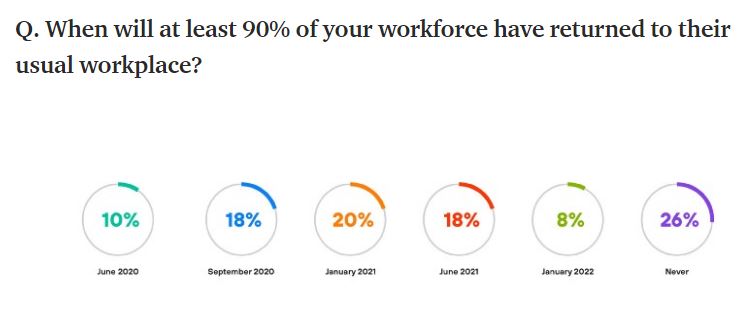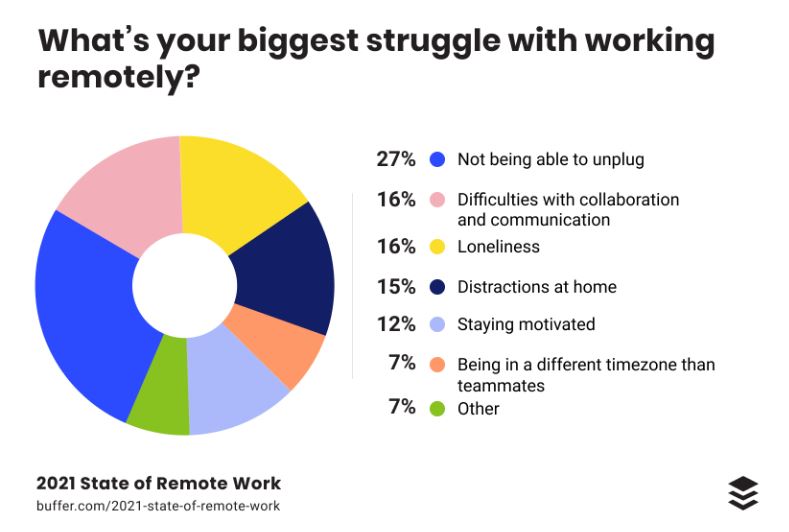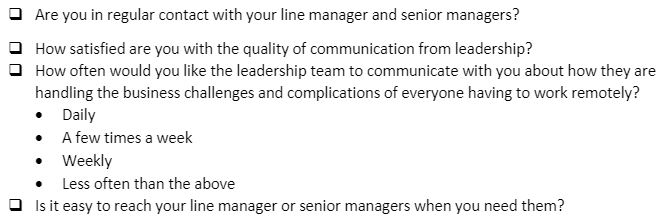Working From Home Survey Questions

When the Covid pandemic first emerged in early 2020, the world changed dramatically. None more so than the world of work. Organisations with office-based employees, suddenly had to change their working arrangements and methods of communications to a remote, home-based one overnight.
This was a massive upheaval. But when the dust began to settle, many employers and staff began seeing some positives to this new working normal.
From greater work-life balance and autonomy for employees, to lower running costs and higher productivity for many employers and more. So much so that when the CEOs of the 2020 Fortune list were surveyed back in 2020, with the following question, 26% thought we would never see a return to the office footfall levels of the pre-pandemic workplace.

Temporary trend or a permanent shift?
It’s not simple to answer whether this shift is temporary or permanent. And this has only been further complicated following the end to the latest Plan B restrictions. The government is now encouraging everyone to return to the office again.
Thoughts on the shift to remote working
However, there have been plenty of companies, particularly within the technology arena like Square, Twitter, Facebook and Shopify, who have fully embraced remote working. In addition, many of these intend to let staff continue working in this way, until after the pandemic has ended.
There are plenty of statistics to back this up too. While 74% of all working professionals believe that remote work will become the new normal, other studies have highlighted that by 2028, 73% of all departments will have remote workers.
Of course, there are and always will be some jobs you can never perform working from home. These can include anyone whose work activities involves tasks such as providing care, operating machinery, using lab equipment and more. However, for the rest of us with more traditionally office-based roles the popularity and trend towards remote working from home refuses to go away.
Positives and negatives reported by employees in 2021
But like anything in life, there can be positives and downsides to anything. And the same can be said for remote working from home.
In their state of remote work report study of around 2, 500 employees in 2021, research specialists Buffer.com, identified about half a dozen key benefits and downsides of staff working remotely.

With the upsides ranging from greater flexibility, work/life balance and no longer having to commute into the office, to downsides including increased loneliness, difficulties with collaboration and communication and being unable to unwind. The studies threw up some interesting findings.

Essentially the research highlights how differently people view and adapt to remote working. However, the interesting thing is that through staff feedback, employers can improve various aspects, so that peoples’ feelings about this way of working become much closer to another. However, you can only get this feedback through conducting a survey.
Why run work from home surveys?
As we’ve just touched on, while there’s plenty of benefits to gain through remote working, there can be downsides too. However, the great thing is that with the right support you can reduce or eliminate many of the downsides. But you will only find that out by asking your staff how they are getting on in a staff survey.
From their immediate working environment and the tools they have to work with, to their ability to continue building relationships and communicate effectively with others, as well as measuring their overall employee wellbeing. There is a lot to consider with home working staff, if you’re to help them feel more comfortable and keep them productive.
It’s why we developed a range of surveys to help customers get through the challenges of the last two years, including employee pulse templates. We even developed a return to work interview template to smooth the process of staff returning to the office between lockdowns. These types of templates will become even more important for feedback, as we learn to cope with future ways of working. Whether that’s completely back in the office, continuing to work remotely, or establishing a more hybrid way of working.
Example remote working survey questions
Wherever you are on your journey, it can be useful to have some questions in mind to ask your staff. Without this you risk struggling to identify, which areas you need to improve.
So, to help you here’s some example remote work survey questions to consider using across different areas.
Questions about working environment and productivity
When Covid first emerged and employers suddenly had to change their employees’ working arrangements, it was very challenging to get each staff member working effectively from home. Whether they needed a decent working space, or better equipment and tools. It took time to get many employees set up to work effectively.
It’s therefore not hard to appreciate that the sooner you have feedback about this, the quicker you’ll be able to make the improvements they need. So, any questions you can ask them to more quickly identify this the better. It can also help you with settling in any new employees that join your business. Quickly enabling them to become productive members of your team.
Useful questions could include:

Relationship questions

Management questions

Questions about communication

Useful questions to explore well-being

Using your results
Having run your remote work survey and analysed the data, you’ll need to decide how to best use the results.
While relaying your survey results is important, the communications process for this is also crucial, as it can either inspire or disengage your staff. So, it’s vital to get it right
Thank staff
Start off with a thankyou email from your senior leaders and HR team for your employees’ participation. You can also include a brief roadmap outlining your next steps.
All of this helps demonstrate to your employees that you appreciate their time and value their feedback.
Provide an initial overview of your results
Next, provide a top-level overview of your survey results. Include areas such as the overall participation statistics, as well as stand out trends and themes, both positive, as well as negative.
Highlighting both ensures employees feel heard and confident that as well as the positives, you will address any areas they are less happy about.
Announce more detailed results
Having analysed your results in more detail with senior leaders and HR, you will be able to provide a more detailed outline of your survey results and next steps.
Besides a more detailed breakdown of your survey results, you should include any actions already taken. You should also include your intended next steps and areas of focus.
If you take all these steps your staff should be confident that you’ll do everything you can to make their remote working experience as good as it possibly can be.
Anonymity
Ultimately the better the results you have to work with, the more positive actions you can take moving forward. So, it’s also worth considering offering an anonymous survey for employees.
An anonymous survey is one that you carry out without asking respondents for any personal or identifiable details. The idea behind this is that when staff know they can’t be identified, they are more likely to provide honest feedback, rather than saying what they believe the survey creator wants to hear. Such feedback is ultimately more valuable to you, by painting a more accurate picture of what’s actually happening.
Final thoughts
When it comes to the world of work and staff working remotely from home, it’s hard to predict with complete confidence how the landscape will look ten years from now. However, what we can say is that more staff are demanding flexible working. And more companies are striving to accommodate flexible working in order to recruit and retain the best talent.
Ultimately, the feedback from a survey will help them to better gauge what their employees want. It will also help employers to better meet those flexibility demands. Whether that’s a full return to the office, fully remote working or a hybrid work approach.


